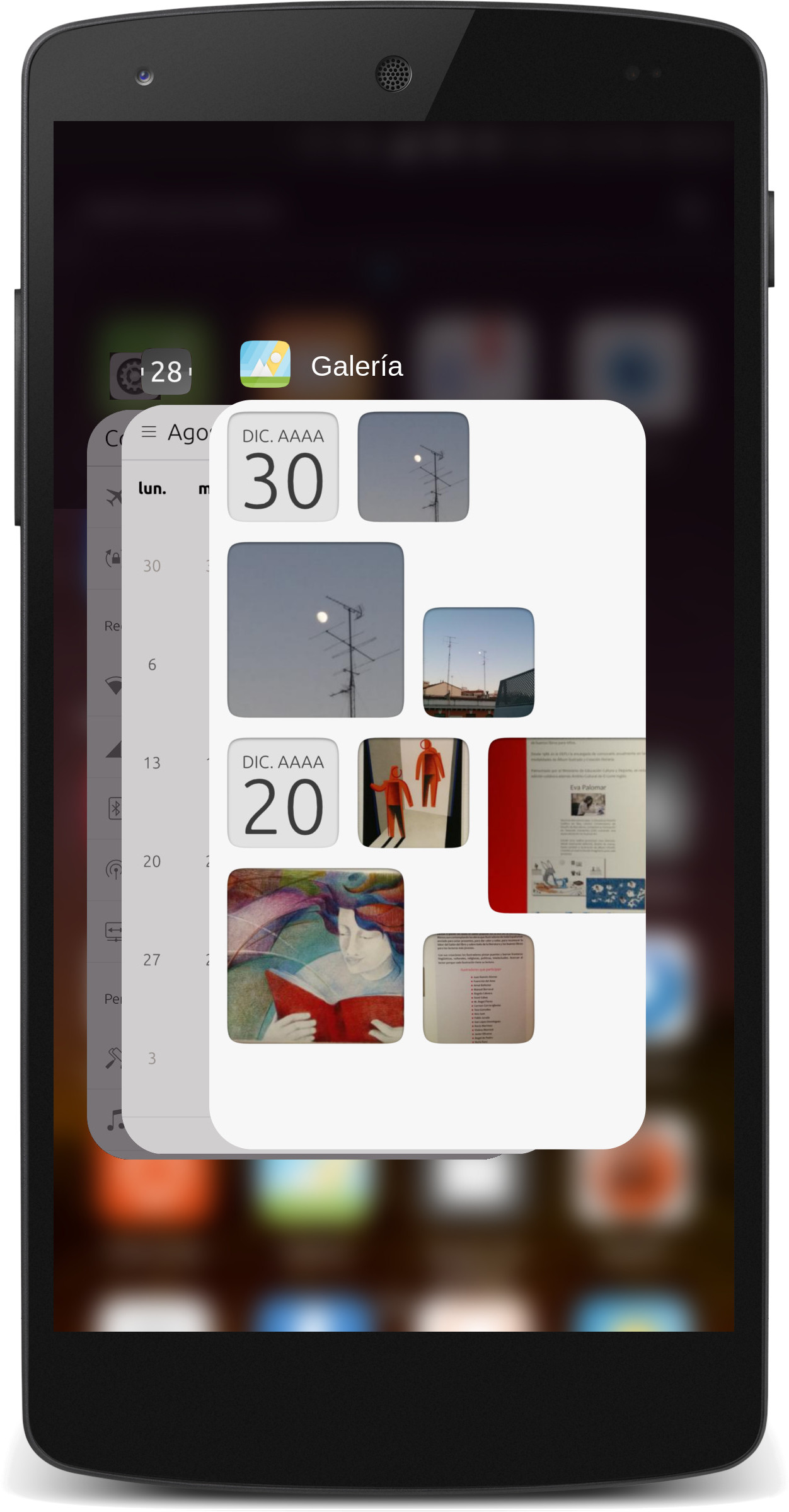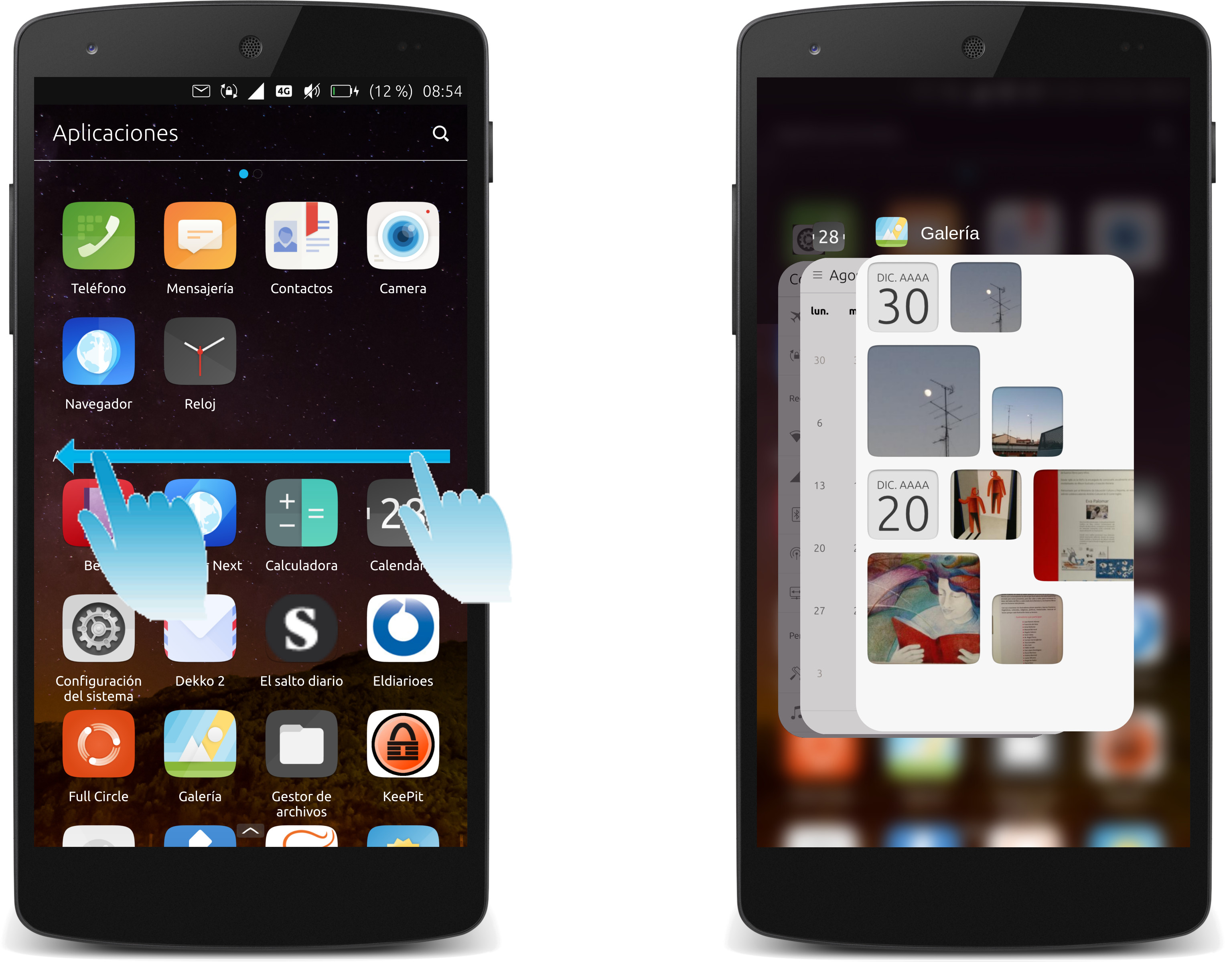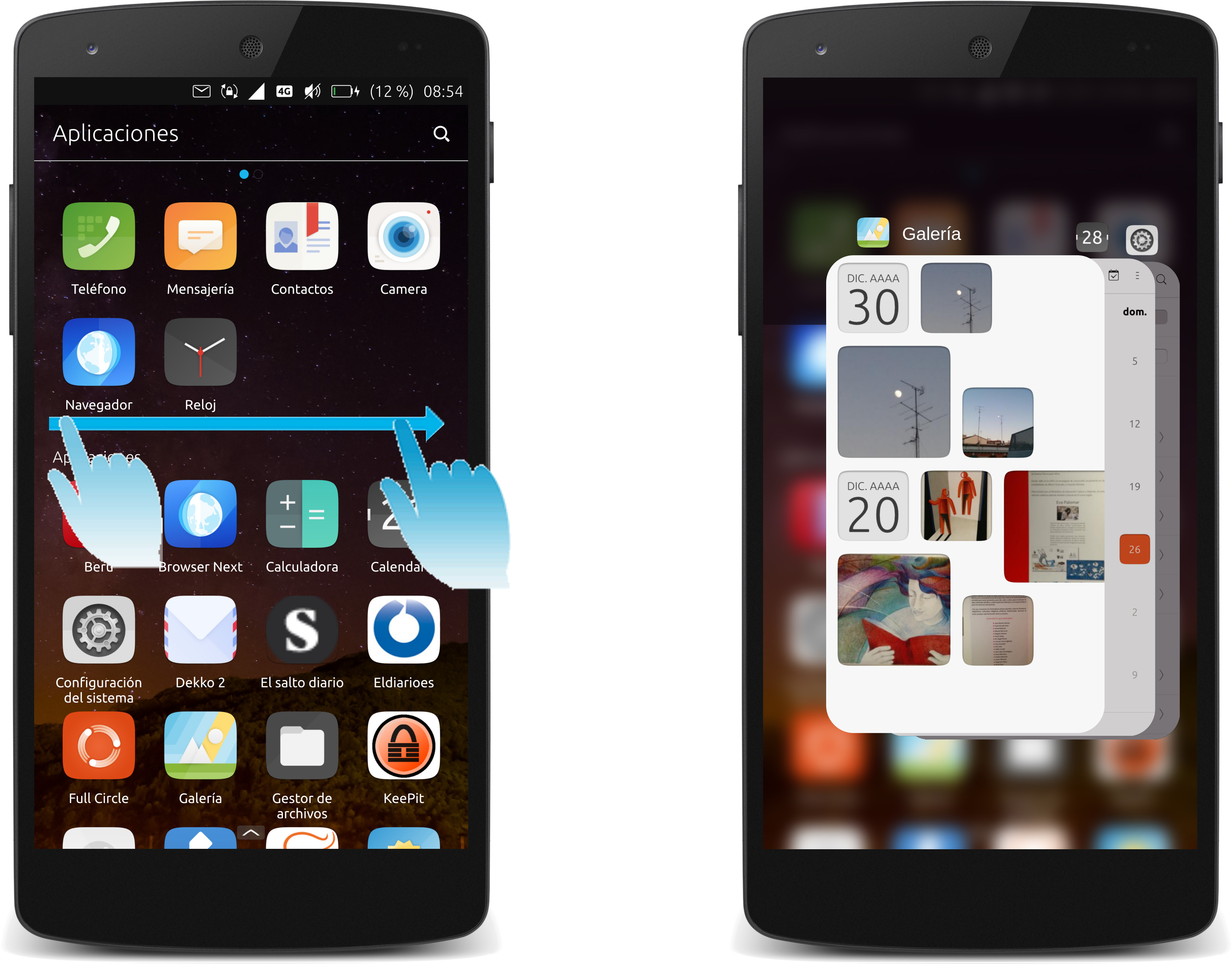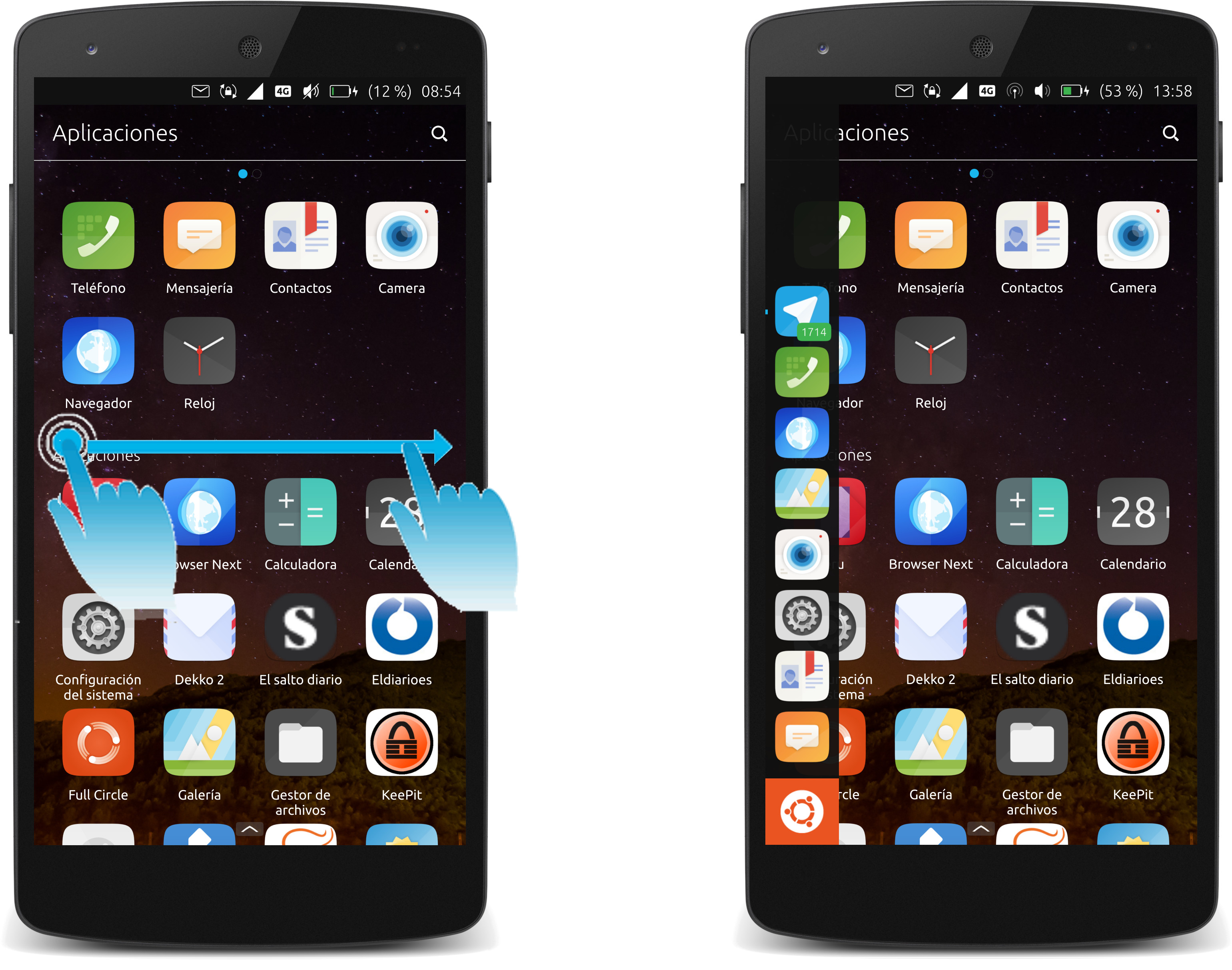UI / UX discussion
-
Hi,
I would like to add my 2 cents to try to improve user interface and user experience (ui/ux) in Ubports and would be very greatful if you could give your impresions about my propposal and add your ideas about the topic.
I haven't seen much discussion in the forum about overall ui/ux. There has been for sure at Canonical and the UX & Graphics telegram group.Looking at how we interact with the system there are the following gestures/actions:
- Drag (left to right) displays the app launcher.
- Drag (right to left from edge of the phone not passing the middle of the screen, we will call it "short.drag") changes to the last app in focus.
- Drag (right to left from edge passing the middle of the screen. from now on "long-drag") displays the app-switcher.
- Drag (top downwards) displays icon menus.
- Drag (buttom upwards) displays scopes or an application specific panel.
I see the following possible improvements (I made some mockups to illustrate it and help understanding it):
1. App-switcher.
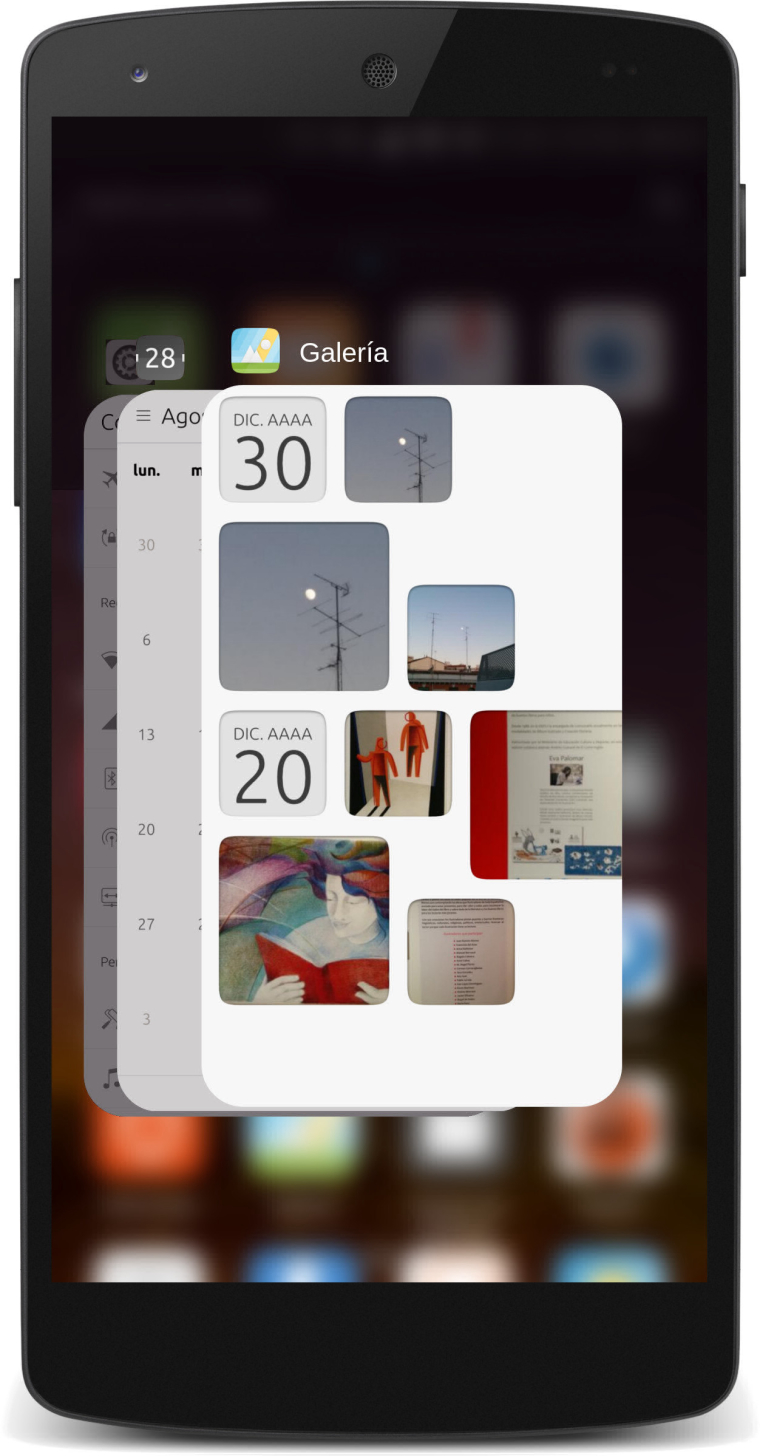
- The last app viewed should be the first of the pile.
- App windows in the pile should be flat (app borders parallel to the screen borders).
- con / (Name) on top of the app window.
- Home scope shouldn´t be showed as a normal app in the app-switcher.
- Home scope at the background blured, if touched, home scope is showned.
- Increase size of app window.
- Make the app windows borders rounded (optional).
2. App Switcher Accesibility.
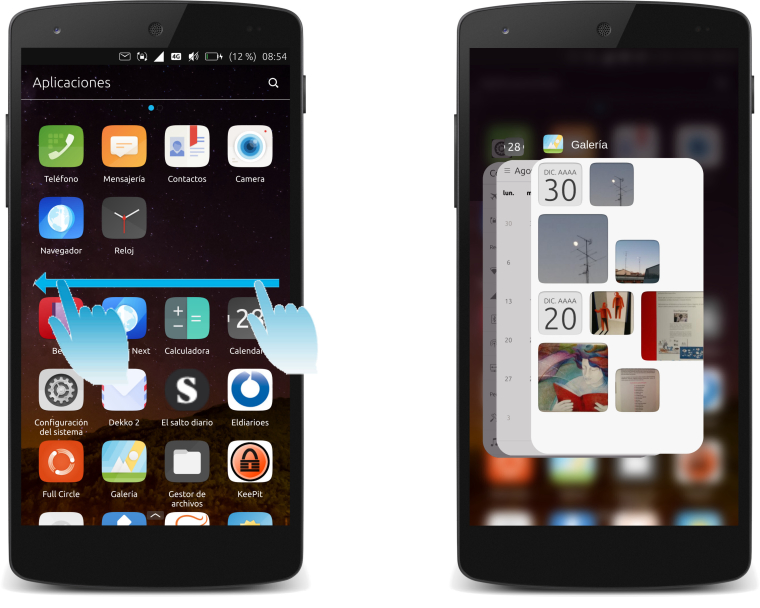
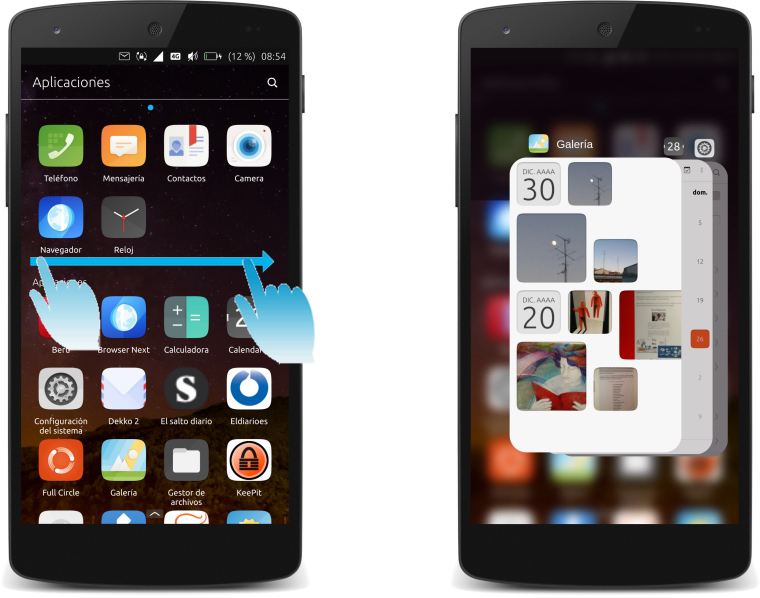
- Access to app-switcher from left and right sides of the screen via long drag.
- App launcher would open via long press and drag (left to right)

3. Navigation through apps.


- Instead moving only to the last app opened, move to the previous (left) or next (right) app.
- This would make possible to navigate faster through apps via short drag.
- Short drag from right side would change to the next app in the pile.
- Left short drag would change to the previous app in the pile.
What do you think about this?
Do you see a way of improving this or other related ui/ux part?
Let´s discuss it and see what we can get. -
@gb That looks nice ...
-
Will it, does it look as good,work as well in landscape also
-
I like the fast app flipping back and forth.
Maybe addlong-drag from the bottomshort-drag from the top to reach the home scope from everywhere?(Long-drag from the bottom seems to be an in-app gesture.)
-
Actually, why not always (and only) show the app launcher together with the tray menu (top downwards), instead of that long-press (if it is possible to distinguish that from long pressing within an app at all).
-
Hey, first of all: Awesome work! The mockups are looking great and I like your ideas. Thank you for your effort.

About 1.: The design is awesome. To make the scopes in background blurred is a very good idea. It is logical for the user that all apps are "on top of" the scopes.
About 2. and 3.: To show the launcher only with a long press would mean that it needs more time to access the launcher. There I would see a problem. The launcher and especially the home button needs to be reachable as fast as possible. But I would agree with: Instead moving only to the last app opened, move to the previous (left) or next (right) app. This would be more logical for the user.
-
@Xray2000 thanks, just trying to contribute

@Marathon2422 I haven´t think about landscape mode and tablet version ( the app switcher could be the same as above or do a specific app switcher for tablet version)
@gnu-mobile reaching "home" is a very important action, that should be very easy and fast to reach. Right now there are 2 ways to do it:
a) open app switcher, select the home scope, so to gestures.
b) open app launcher and select home icon. This icon is quite difficult to reach (right handed person) depending how you are holding the phone.
This is why I proposed to leave the home scope at the background so you can go to home from every corner once the app switcher is opened.
There could be other solutions like the ones used by android and ios having a button at the bottom of the screen. (Switch apps on iPhone X)
About your idea of showing app launcher with the tray menu, I think there is not enough space for booth at the same time.@Krille welcome
 I think we need some discussion about this.
I think we need some discussion about this.
1): This is related with scopes idea that Canonical promoted. Having the icons in the background has to do with the desktop metaphor. ios and android used them and have options like having "folders" to group them. I don´t know what is going to happen with scopes but this would be another theme to talk about. I did not wanted to open to many themes at the same time.
2). I personally don´t use too much the app launcher. Do you use it?
It would be interesting to have a measuring system to know how people interact with their phones in order to prioritize between design options. -
@gb c) Home scope can also be reached with a "long-drag" from left to right. (The "short-drag" from left to right opens app launcher only)
-
@gb
I was thinking about my m10 fhd for landscape.
and actually looking at your post on a pro5.
It looks great.
Nice to have ideas like this coming in. -
@gb the app launcher is not easy to reach for right handed users. So I most use the apps overview und search the scopes app.
For left handed users its the opposite I think. For them its hard to reach the apps overview. So I would say its important that Ubuntu Touch gets a left-handed-mode which switches the actions on the edges. -
This could work nicely and symetrically:
- Let the short-swipes (left and right) flip between apps AND open the app launcher (on left or right side), IF the short-swipe was made say in the upper or lower part of the display (near the corners).
This would provide the app launcher for both hands.
-
Long-drag from left could also open the app-switcher, like on the right for symmetry (as in the original proposal), and...
the short-drag from the top could open the home scope (or home menu / drawer) instead, while long-drag opens the tray menu. (The bottom edge remains app-specific.)
-
Some issues here:
-
The dash (scopes) is an app, but is special cased and should always appear at the bottom of the stack.
-
The dash is not like traditional home screens on phones. It is not a part of the background, but as noted above, is an app.
-
Scopes are going away in the future, and apps scope is replaced by app drawer.
-
Short swipe from left edge opens the launcher, while long swipe returns to the dash (or will open app drawer when dash is replaced).
-
Long press and then drag is not suitable for the design of UT, and would require breaking apps to be able to do this while an app is focused. I don't think we can do this (and it doesn't make sense, when short swipe from edge already opens the launcher panel).
-
As above, short swipe from left edge opens launcher panel. I don't think we should replace that with quick app switching in reverse. I don't have any special qualms about cycling through apps with short swipe from right, rather than just switching between last 2 apps, but the right edge swipes are designed to work more like the "apps" button on Android phones, where double tap switches between last two apps, and one tap opens the app switcher; here having short swipe mimic double tap, and long swipe for single tap.
-
-
@krille I think this is more an issue with phone sizes having gotten a bit out of hand (good pun that). This is not an issue on reasonably sized phones, that are 4.5-5.0" screens, but on 5.5-6.2" screens any interface becomes difficult to use with one hand.
Remember the Ubuntu Edge design was I think a 4.6" screen.
-
@dobey is right on the money here, introducing changing apps from the left to right, will make the ui more difficult to navigate, and make it VERY difficult, to open apps.
You can't tap the background to get to apps, you have to swipe from the left.
We aren't keeping scopes, what will replace them is uncertain, but launching apps is done by the app draw not the app scope in the near future.
-
@phoenixlandpirat said in UI / UX discussion:
We aren't keeping scopes, what will replace them is uncertain, but launching apps is done by the app draw not the app scope in the near future.
Even as a stopgap solution I think it will be insufficient to only have the drawer. It doesnt scale beyond a handful of icons
-
@gb What would be your take the ideas to make the user interface even more symetric?
- opening the app launcher when flipping left/right, if flipping near the upper and lower corners.)
I second, I have not thought about it before seeing your improvement draft above, but now I notice that what I do not like so much with the current ubuntu touch is that getting to the home screen (scope, drawer, whatever) is not a fast gesture. The quickest is currently the long-drag from the left. The long-press as you suggested would not be fast either, and does not seem to be technically possible.
Therefore, I think it might be a cool, fast way to
- quick-swipe from the top to open the "home menu".
And thus allow to make the interface completly symetric, no matter if holding the device in the left or right hand.
-
@doniks said in UI / UX discussion:
Even as a stopgap solution I think it will be insufficient to only have the drawer. It doesnt scale beyond a handful of icons
It should be fine. The app drawer has search, scrolling, etc… and can be extended to have other views if necessary.
-
@phoenixlandpirat I realize that they are somewhat out of fashion and rather neglected, but I still think scopes have the potential to offer more than an app. They could be a real differentiator for UT.
-
@3arn0wl said in UI / UX discussion:
@phoenixlandpirat I realize that they are somewhat out of fashion and rather neglected, but I still think scopes have the potential to offer more than an app. They could be a real differentiator for UT.
The entire point of scopes was they offered less than apps, and were easier to develop. Continually adding features to make them more like apps was the result, and they were never enough of a difference to make UT unique through their existence.
The back-end and core ideal of what scopes are might be salvageable in the future, but as scopes exist today, they just need to go. They are not essential, overly complex, and increase the maintenance burden.
